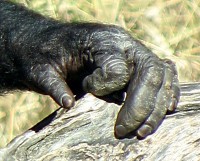I was inspired by a recent debate I participated in to present here a brief outline of the evidence that exists for evolution. I'm
not the first to do this, and this is far from an exhaustive resource, but hopefully I'll be able to provide a good starting point for any evolution deniers who are genuinely interested in learning more about it.
Where did the idea of evolution come from?
It's a common misconception that the theory of evolution was developed, in whole cloth, by
Charles Darwin and remains dogmatically unchanged to this day. This is not the case.
The idea of biological evolution seems to date back to the
philosophers of ancient Greece, who noticed anatomical similarities between different life forms, and postulated that those life forms might share some sort of common ancestor.
This idea fluctuated in its popularity, but remained pretty firmly in the realm of philosophy until Charles Darwin provided a plausible mechanism through which evolution might work: natural selection. Only then did evolution transform from an idea to a theory - it could make predictions that could be tested.
And tested it was. Since Darwin's first publication,
On the Origin of Species, much has been learned about biology, and all of it, so far, has fit neatly into the Theory of Evolution. Sure, a lot of the details had to be rethought, but no evidence produced so far has refuted the theory as a whole.
Okay, so what's the evidence?
As with most
theories, there is no one piece of evidence that can prove or disprove evolution. That's not how science works. Rather there are multiple lines of evidence that all converge at a point, and that point is very successfully explained by the theory of evolution.
The first evidence, that which gave rise to the idea to begin with, is that of anatomical similarities between species. This is something we can see with our own eyes.
Look at your hand. It's attached to the end of a limb. One of four similar limbs. It probably has five digits - four fingers and an opposable thumb.
Now look at a chimpanzee's hand. It's very similar, isn't it? It's also at the end of one of four limbs, and also consists of five digits - four fingers and an opposable thumb. A chimp's hand is a little different though. It's hairier, and the comparative lengths of the digits is a little different.
Now look at a monkey's hand. Again, very similar, but not quite as similar. Now look at a lemur's hand. And a rat's. And a lizard's. And a frog's.
If you line up all these images you can almost see a steady progression from frog hand to human hand. It almost looks as if frogs possess the primeordeal hand, and that lizards, rats, lemurs, monkeys, chimps and humans all descended from the frog, collecting upgrades to their hands as they went.
This isn't how it happened, but it's not far off. What it does suggest is that chimps and humans had a common ancestor... one that probably looked more like a chimp than a human. And that that common ancestor probably had another common ancestor shared with modern monkeys - one that probably looked more like a monkey than a chimp, and so on all the way back to frogs.
Okay, so now we have the makings of a hypothesis. In order to test it, we need more evidence.
What else do we now know about living things? They have DNA which is passed down from one generation to another. We know that DNA is largely responsible for determining what we look like, how we act and what we do. So if chimps and humans have a recent common ancestor, we can predict that they would probably have very similar DNA. Right?
Well, that has been tested. And guess what?
Humans and chimps have very similar DNA! Not only that, humans have DNA that is similar to monkeys, but not as similar as to chimps. And even less similar to lemurs. And so on, all the way down to frogs.
Okay, so we now have one line of evidence that points to evolution being true. Of course there are other possible explanations for the DNA similarity. And that's okay. What we need to do is look for other predictions that evolution makes, and test those.
If humans and chimps had a common ancestor, it would probably have been very long ago. Millions of years. We know this because
we know the average mutation rate of human DNA, and therefore we can come up with a pretty good estimate of how long it would take something like a chimp to evolve into something like a human, one mutation at a time.
So how do we find out whether animals existed in the distant past? Unfortunately there's no good way of doing that. But there is one way:
fossils.
Sometimes an animal dies in just the right spot at just the right time and impresions of its body are preserved in rock. This is very rare, and we're lucky to have any fossils at all. But we do have a few... just enough to see that animals
once existed that were something like a chimp, and also something like a human.
We can also tell, by using
various techniques, how old the rocks are that the fossils are preserved in. This gives us a rough date of when that animal lived. If that date is close to the date predicted by evolution, we have another confirmatory line of evidence on our hands. And guess what! It matches!
Again, it's still possible that it's just a coincidence that humans and chimps share DNA and that an animal once existed that looks like it may have been a common ancestor of both. There are still other hypotheses that could explain both of these. So how do we go about determining the better theory?
One way is by applying the same test to other species. If we see the same pattern of DNA similarity and fossil record apply to lots of other species, it lends considerable weight to the evidence. This, also, has been done. And guess what?
It confirms it!
So what do we have? We have a theory that makes some pretty clear predictions. Those predictions have been tested, and the theory has been upheld. So it's plausible. But is evolution actually possible? Can we see organisms developing new traits as a result of random mutations coupled with natural selection?
Yup.
Is that it? Three lines of evidence?
Well, yes and no. What I've given here is a very broad oversimplification of the lines of evidence supporting the theory of evolution. Each of these lines of evidence actually consists of hundreds, if not thousands, of individual strands of evidence. The depth of this subject, and its many, many forms of evidence, is enough to keep some of the brightest people busy all the time. I encourage you to explore them, as I have been doing.
One strand on it's own is weak, and can't withstand much scrutiny. But the combined strength of all those individual strands, all aligned in the same direction, makes the Theory of Evolution one of the most reliable ideas known to science. Evolution isn't just a fact, it's an orchestra of facts, playing in harmony the music of life as we know it.
Evolution is us.







